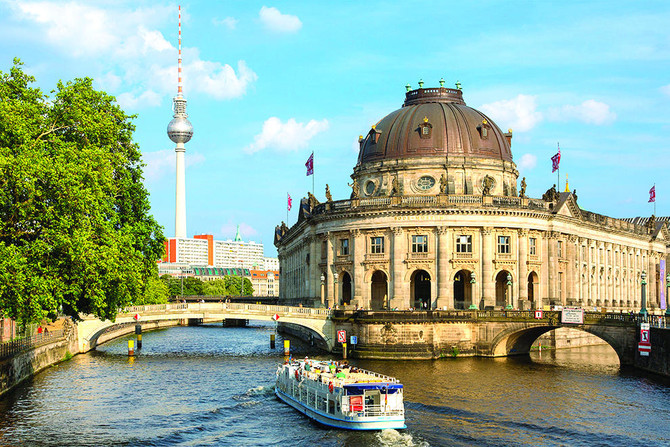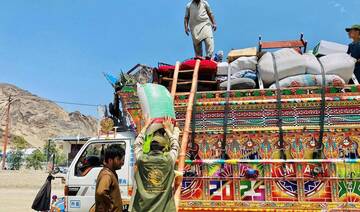RIYADH: Germany, which ranks as one of the world’s best tourism destinations, is also regarded as one of the safest countries for business, medical tourism and leisure.
Since reunification, Germany gained a higher profile as a place to visit, thanks partly to the remarkable resurgence of Berlin, one of the most fascinating and exciting cities in Europe. But the appeal of the reunified Germany is not limited to the German capital only. There are hundreds of places to see in Germany besides hundreds of avenues to enjoy.
On the one hand, Germany is famous for lifestyle, art and culture; while on the other, it is equally important for business and leisure. Germany’s contribution to the world of art and classical music is undeniable, and provides a powerful pretext for a visit, whether to experience the glories of the Berlin Philharmonic or of Wagner’s Ring at Bayreuth, or to follow in the footsteps of great composers: Bach in Leipzig, Beethoven in Bonn.
“Germany’s reputation as the cradle of modernism is also well deserved. German modernism was preceded by the older traditions of the Romanesque, Gothic, Renaissance, Baroque and Rococo, each of which left a rich legacy of artistic and architectural treasures,” said a report on tourism released by the German government. Germany’s prowess in fine art is less well known, yet from the pioneering realism of Albrecht Durer to the ethereal Romanticism of Caspar David Friedrich, it’s a powerful tradition that is well worth discovering.
Most German cities of any size have excellent galleries, with Berlin and Cologne hubs of the European contemporary art scene. The pleasures of a visit to Germany are not only intellectual. Germany’s food culture is traditionally characterized by wholesome but hearty dishes, a vast array of sausages and excellent but calorific cakes. Yet the impact of immigration, travel and increasing culinary ambition has been powerful, and most towns nowadays offer a wide selection of international options, usually including Balkan, Greek, Italian and Turkish.
“Germany offers all what is praiseworthy and what one wants to see as well as experience,” said German Ambassador Dieter Haller, while referring to the growing popularity of German cities in terms of tourism. In fact, Germany is the seventh most visited country today with a growing number of wealthy tourists from Arab countries streaming into Germany. In fact, one unsung pleasure of a visit to Germany is the opportunity to meet its people.
In terms of medical tourism, Germany is far ahead. Many consider the German health care system as one of the best in Europe and around the world. German hospitals have been a primary health travel destination in Europe for hundreds of years and continue to lead the industry today. Patients from Eastern European countries such as Russia, Romania and Bulgaria, besides many Arab nations, who have the resources to pay for high quality medical services, usually seek medical care abroad and Germany is a primary choice.
Medical travelers from Great Britain and the United States are also attracted to Germany’s hospitals mainly because of the high level of medical care and technical advances offered by the German healthcare system. Coming to Germany as a medical tourist also enables the Western medical travelers to reduce the waiting times which are common in many other countries. Patients from the Gulf and Arab nations come to Germany to avail themselves of the expertise and reputation of the German doctors.
Germany is ideal as a destination for health and relaxation — whether travelling with the whole family, unwinding after a business trip or engaging in active pursuits. With around 200,000 km of walking trails and 70,000 km of cycle paths you can explore the country at its most unspoilt, getting close to nature while being kind to the environment. Along the way one will discover amazing and diverse natural landscapes. More than one third of the country’s land area is under some form of protection.
With a total of 16 national parks, 15 UNESCO biosphere reserves and over 100 nature parks, there are more than 130 preserved national landscapes just waiting to be explored. Indeed, Germany offers a wide range of options for sustainable travel. Its leafy towns and cities boast excellent public transport networks and a good cycling infrastructure. Hotels and restaurants support the use of regional produce within a very lively culinary scene that will delight anyone who enjoys good food.
Many attractions and amenities also cater for disabled guests through the ‘Tourism for all” project. The largest city in Germany’s federal state of Saxony, Leipzig is known for its vibrant arts and culture scene shaped by famous music composers like Bach, Richard Wagner and Felix Mendelssohn. Tourists today can enjoy performances of Bach’s music at the St. Thomas Church where Bach once served as choir leader and is now buried. Located in the Baltic Sea, Rugen Island is another attraction and is the largest island in Germany, connected to the mainland by the Rugen Bridge and Rugen Causeway.
Charming villas, romantic seaside resorts and beautiful beaches all draw tourists to Rugen Island, but the star attraction is the Jasmund National Park, famous for its unique chalk cliffs rising 528 feet (161 meters) over the sea. Another notable feature of Rugen Island is Cape Arkona, East Germany’s northernmost tip, where tourists can visit an old lighthouse, remnants of a Slavic castle and a picturesque fishing village.
Another major attraction is Romantic Rhine stretching between the cities of Bingen and Bonn, the Middle Rhine flows through a dramatic geological formation called the Rhine Gorge. This region features a spectacular landscape dotted with some 40 medieval castles, picturesque villages and terraced vineyards. The region’s most famous natural attraction is the Lorelei, the deepest and most narrow section of the Rhine Gorge, which features a large, treacherous rock that caused several boating accidents prior to the 19th century. The best way to experience the Romantic Rhine is by a riverboat cruise.
Another one of the most beautiful cities in Europe is Munich in Germany. Best known as the origin of the world famous Oktoberfest, Munich is one of the best places to visit in Germany with a great culture scene. Munich is home to several sophisticated opera houses and theaters like the National Theatre. The city center is an attractive blend of classic and modern architecture, teeming in historic churches, medieval walls and royal palaces as well as bustling shopping centers and nightlife venues. Munich’s Oktoberfest began in 1810 with a royal wedding celebration. Today, this famous beer festival draws millions of visitors every year to take part in the revelry that involves several gigantic beer tents, delicious Bavarian food and millions of liters of beer.
Then comes the capital city, which is the most important city not only in Germany but in the whole of Europe from tourism and business points of view. A federal state and the capital city of Germany, Berlin is widely associated with its World War II history and former division of East and West Germany by the Berlin Wall during the Cold War. Since the fall of the historic wall in 1989, Berlin today is now a vast, unified city diverse in ethnic groups and abundant in sightseeing attractions, culture and nightlife. Many tourists are drawn to Berlin’s famous historic structures, which include the Brandenburg Gate and the Reichstag. Although most of the Berlin Wall was demolished, there are some portions still standing near Checkpoint Charlie and Reichstag.
Then, no one can deny the attraction of Cologne, situated on the Rhine River in the German federal state of North Rhine-Westphalia, Cologne is one of the most popular places to visit in Germany. The city offers a vibrant array of attractions, buzzing nightlife and a stellar arts and culture scene. Cologne also packs impressive landmarks such as the city’s informal symbol, the Cologne Cathedral, a stunning Gothic church. Moreover, the Twelve Romanesque Churches are magnificent examples of medieval architecture.
Another city in Germany which attracts sizeable number of tourists is Dresden. Before it was severely damaged from World War II bombings, Dresden was known as the Jewel Box because of its lavish collection of stunning art and architecture. After many years, the city has restored much of its former glory. The capital of the federal state of Saxony, Dresden offers a number of historic sites like the stunning Frauenkirche cathedral. The city also boasts many cultural institutions of which the Semper Opera is most widely esteemed.
As one of the largest Baltic seaports in Germany, Lubeck is a tourist place to see, it is located in the country’s northern-most state, Schleswig-Holstein. Founded in 1143, Lubeck served for several centuries as the capital seat of the Hanseatic League. Although it was the first German city to be bombed and damaged during World War II, Lubeck still retains much of its medieval architecture, making it a popular tourist destination. A walk through the narrow streets of the Altstadt offers views of historic sites like the stunning cathedral, the 12th century Town Hall and the old city gates of which the Holstentor is the most famous.
Any tourist visiting Germany should also not miss Heidelberg. With historic treasures like the medieval Old Bridge, the Heidelberg Castle, the Church of the Holy Spirit and the Knight St. George House, it is no wonder that Heidelberg is a popular tourist attraction. The city center’s main street, Haupstrasse, is packed with pubs, restaurants, museums, art galleries, shops and markets. Home to Germany’s oldest university, Heidelberg’s long academic history can be retraced along the Philosopher’s Walk, a scenic footpath often walked by many earlier philosophers and professors.
On the other hand, the most photographed building in Germany, Neuschwanstein Castle, is also one of Europe’s most popular tourist destinations. Nestled among the breathtaking beauty of the Bavarian Alps near the town of Fussen, this fairy-tale castle served as the inspiration behind Walt Disney’s Sleeping Beauty Castle. Constructed in the late 1800s, Neuschwanstein Castle was never built for defense purposes as most castles. Instead, this castle was created as a fanciful retreat King Ludwig II of Bavaria who had a reputation for abiding in daydreams instead of reality.
Germany is one of the world’s best and safest holiday destinations
Germany is one of the world’s best and safest holiday destinations

KSrelief’s efforts alleviate suffering worldwide

- Among the Kingdom’s most notable humanitarian achievements is the Saudi Separation of Conjoined Twins Program, launched in 1990, which has gained regional and international recognition for its excellence
RIYADH: Saudi Arabia continues to consolidate its leading role in international humanitarian work, embodying the values of generosity and human solidarity through wide-ranging relief efforts across the globe.
Since its inception, the Kingdom has provided more than $142 billion in humanitarian, development, and charitable assistance and implemented 8,457 projects in 173 countries worldwide.
The King Salman Humanitarian Aid and Relief Center was established in 2015, with the aim to boost transparency, impartiality, and professionalism.
Its work extends beyond the provision of emergency assistance to include empowering affected communities and enhancing their capacity to recover from crises, reflecting the Kingdom’s enduring commitment to sustainable humanitarian impact.
Among the Kingdom’s most notable humanitarian achievements is the Saudi Separation of Conjoined Twins Program, launched in 1990, which has gained regional and international recognition for its excellence.












